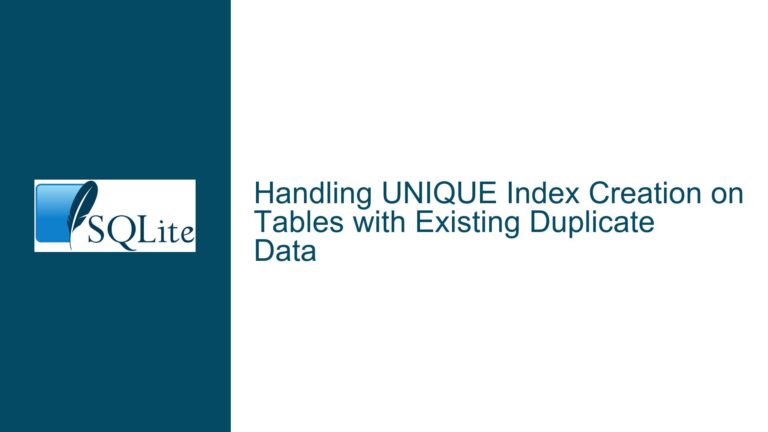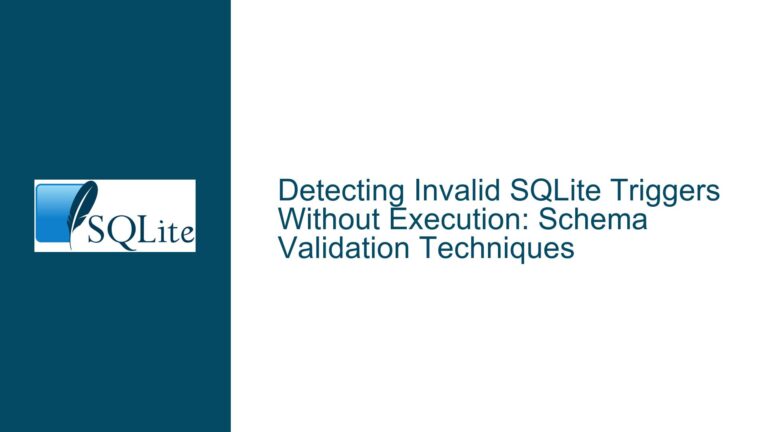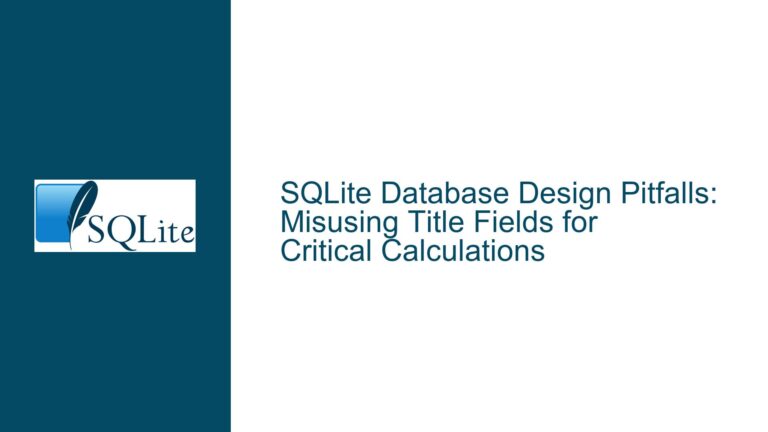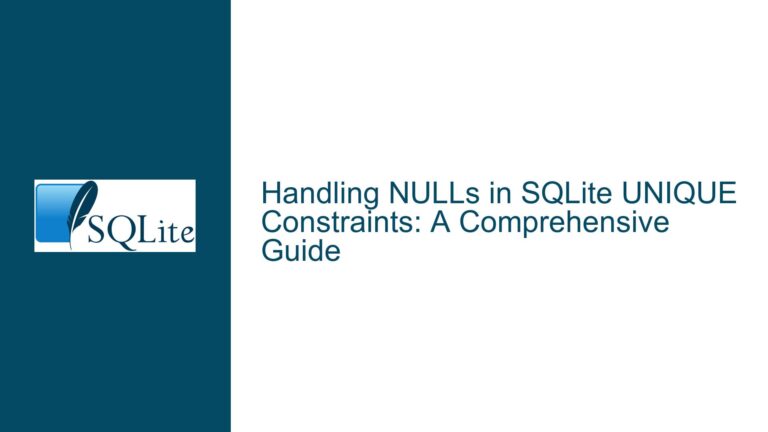Designing High-Throughput Ephemeral Queues in SQLite: Schema Tradeoffs and Concurrency Pitfalls
Queue Architecture Challenges in SQLite-Based Messaging Systems
Implementing high-volume ephemeral queues in SQLite requires navigating three fundamental tensions: the granularity of schema containment (single vs. multiple tables), write contention patterns under WAL mode, and the operational overhead of managing thousands of transient data stores. At 40,000-100,000 concurrent queues each processing 30-40 messages within 8-10 minute windows, the system must handle 120,000-4,000,000 total messages during peak loads while maintaining sub-second latency for enqueue/dequeue operations. This creates four critical pressure points: 1) Lock contention during parallel writes to shared structures 2) Index fragmentation from rapid insert/delete cycles 3) Filesystem strain from metadata operations on queue tables/files 4) Connection pool exhaustion under high concurrency.
The single-table approach centralizes message storage with a queue_id column and composite indexes, simplifying schema management but requiring meticulous index tuning to prevent page splits during rapid inserts. Multi-table strategies isolate each queue to dedicated tables (or database files), eliminating global index contention but multiplying DDL operations and VFS layer pressure. WAL mode’s writer starvation prevention mechanism introduces commit serialization – a bottleneck exacerbated when queues share write-heavy tables. Ephemeral queue semantics demand aggressive vacuuming strategies to prevent table/index bloat, complicating both architectures differently.
Concurrency Limits and Schema-Induced Latency Spikes
Write amplification emerges as the primary performance killer across both designs, but through different mechanisms. In the single-table model, each INSERT requires updating the clustered index (typically on (queue_id, message_order)) and any secondary indexes for message metadata. With 40,000 queues generating 30 messages each over 10 minutes, this translates to 2,000 inserts/second competing for B-tree modifications. SQLite’s table-level write locks (in WAL mode) serialize these operations, causing queue backpressure as transaction commits queue up behind exclusive locks.
Multi-table architectures sidestep this by sharding writes across independent tables. However, creating/dropping tables at scale (100K tables/hour) triggers three hidden costs: 1) SQLite’s internal schema cache invalidation overhead 2) Filesystem inode exhaustion from rapid table creation/deletion 3) Prepared statement invalidation across connections. Each CREATE TABLE queue_12345 statement increments the schema version counter, forcing all database connections to reparse their prepared statements – a catastrophic penalty at 100+ tables/second.
Filesystem journaling modes compound these issues. Ext4’s default data=ordered mode forces metadata writes before data commits, turning table creation into a synchronous operation. This manifests as 100-300ms latency spikes per table creation – unsustainable at 100K tables/hour. Switching to data=writeback with barrier=0 risks metadata corruption but may be necessary for throughput.
Optimized Implementation Framework for Ephemeral Queues
Sharded Single-Table Architecture with Partial Indexes
Create a partitioned single table using modulus-based sharding:
CREATE TABLE message_shard_0 (
queue_id INTEGER NOT NULL,
message_id INTEGER PRIMARY KEY,
created_ts INTEGER NOT NULL DEFAULT (strftime('%s','now')),
payload BLOB,
CHECK (queue_id % 10 = 0)
);
CREATE INDEX idx_shard0_active ON message_shard_0(queue_id)
WHERE deleted = 0;
Sharding by queue_id % N (N=shard count) enables parallel writes across shards while keeping queue messages contiguous. Partial indexes on deleted=0 reduce index maintenance overhead during queue expiration. Batch deletes use timestamp ranges:
WITH expired_queues AS (
SELECT queue_id
FROM queue_metadata
WHERE max_message_ts < strftime('%s','now','-10 minutes')
LIMIT 100
)
DELETE FROM message_shard_0
WHERE queue_id IN (SELECT queue_id FROM expired_queues);
Combine with aggressive PRAGMA schema.shrink_memory after batch deletes to combat index fragmentation.
Hybrid Multi-Table Strategy with Attach/Detach Cycling
For queues requiring isolated write throughput:
- Pre-create 500 database files per directory (limited by filesystem inode cache)
- At queue creation time, ATTACH a pre-created DB:
ATTACH DATABASE '/queues/pool/db_12345.sqlite' AS new_queue;
CREATE TABLE new_queue.messages (...);
INSERT INTO registry VALUES (12345, '/queues/pool/db_12345.sqlite');
- During expiration, mark DBs for detachment instead of immediate deletion
- Periodically DETACH and vacuum marked databases in bulk:
DETACH DATABASE expired_12345;
sqlite3 expired_12345.sqlite "VACUUM; PRAGMA optimize;"
This avoids filesystem metadata churn by recycling database files. Use a registry table to track attached queues and their physical files.
Concurrency Tuning Parameters
- Set
PRAGMA journal_size_limit = 32768to prevent WAL overgrowth during queue spikes - Configure
PRAGMA cache_size = -20000(20MB) per connection to buffer hot queue data - Enable
PRAGMA busy_timeout = 50with exponential backoff in application code - Limit total connections to
min(100, (ulimit -n) / 2)to avoid file descriptor exhaustion - Use separate WAL directories (
PRAGMA journal_mode = WAL; PRAGMA wal_dir = '/wal') to isolate queue storage from WAL files
Monitoring and Diagnostics
Implement real-time metrics using PRAGMA schema.table_info and sqlite3_stmt_status:
// Track index efficiency
sqlite3_db_status(db, SQLITE_DBSTATUS_CACHE_USED, &cache_used, 0);
// Monitor statement performance
sqlite3_stmt_status(stmt, SQLITE_STMTSTATUS_VM_STEP, 1);
Set up alerting when sqlite3_status(SQLITE_STATUS_MEMORY_USED) exceeds 80% of available RAM, indicating memory pressure from temp tables or sorting.
Ephemeral queue implementations in SQLite can achieve 10,000+ transactions/second on NVMe storage when properly sharded and tuned. The critical path optimizations involve minimizing index updates through partial indexes, preallocating database/file resources, and implementing application-level connection pooling that respects SQLite’s write serialization constraints. For workloads exceeding 100K queues/hour with sub-100ms latency requirements, consider supplementing SQLite with a lightweight message broker like Redis Streams or NATS JetStream for ingestion, using SQLite as a durable backing store.






